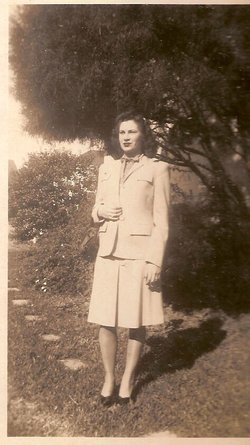
It was the photo that caught my attention. I'd been looking for something else when coming across it on Reddit. Struck by its clarity and perspective, seemingly taken from the viewpoint of the chickens in the bare dirt yard; the adult man and woman, along with six children, five girls and a boy, posed in front of a rough wooden unpainted home, far enough away that their features were indistinct, and accompanied by this inscription, I decided to find out more:
"Family of Seaman 1/C Johnnie D Hutchins who was mortally wounded on September 4, 1943 when he turned LST-473 from the path of Japanese torpedo. He was posthumously awarded the Medal of Honor. Family home, Lissie, Texas, 1944."Johnnie D Hutchins was born during 1922 in Weimar, Texas, a town of about 1,000 inhabitants halfway between Houston and Austin, one of eight children (a daughter died in 1941 before this photo was taken). Soon thereafter the family moved to Lissie, a smaller town, about 40 miles closer to Houston, where Johnnie graduated from Eagle Lake High School. His father, Johnnie Marion Hutchins, was a farm laborer, his mother Cally Drue Cooper.
Graduating from Eagle Lake, where he played on the football team, Johnnie worked at a shipyard on the Houston Ship Channel before enlisting in the Navy in November 1942. After training he was sent to the Pacific Theater, where on September 4, 1943 Seaman First Class Hutchins found himself on LST (Landing Ship, Tank) - 473 carrying troops of the Australian 9th Division, along with its normal complement of 163 naval officers and crew, as it approached Lae, New Guinea. His ship was part of a small flotilla of six LSTs, three minesweepers, and two subchasers, which came under heavy attack by Japanese dive bombers and torpedo planes.

(LST-473 in the South Pacific)
Japanese Val dive bombers scored two direct hits on Johnnie's LST, killing six Americans, wounding 31 (including 18 Australian soldiers) and igniting fires, just as the helmsman and Johnnie spotted a torpedo heading directly towards the craft. One bomb hit the pilot house, wounding the helmsman and throwing him clear from the structure. Hutchins, also in the pilot house, was badly wounded in his torso and tossed to the deck. Struggling to his feet, he reached the helm as the torpedo continued to close. Grasping the wheel he turned it to the right, causing the torpedo to miss the 328 foot vessel with little room to spare, saving countless lives. By the time his shipmates reached him Johnnie was dead, his hands still tightly gripping the spokes. The crew were able to extinguish the fires from the two bombs and save the boat.
Along with saving lives, Hutchins' action preserved LST-473 which went on to participate in four more Pacific operations including landings at Leyte (October 1944) and Lingayen Gulf (January 1945).
On May 2, 1944 the U.S. Navy commissioned the destroyer U.S.S. Johnnie D Hutchins, his mother christening the ship with the help of Johnnie's 17-year old fiancee, Ruby Mae Butler. On September 21, 1944 at a public ceremony at the Houston Coliseum, Admiral AC Bennett presented the Congressional Medal of Honor to Johnnie's family. The Hutchins family used the death benefit of $475.20 to purchase the home they rented.
After the war, Johnnie's body was returned from New Guinea and reburied at Lakeside Cemetery in Eagle Lake. He has not been forgotten. Eagle Lake named a street after him and, in 2000, surviving shipmates from LST-473 gathered at the cemetery for a memorial service. A building at the Naval Air Station in Dallas is named after him. In 2017 the Texas Legislature passed a bill designating Alt US-90 within Wharton County as Johnnie David Hutchins Memorial Highway.
In 2001, the family donated his Medal of Honor to the National WW2 Museum in New Orleans, where it is on display. In 2012, Johnnie's brother Harold, who was only five when Johnnie died, recorded this brief oral history for the National WW2 Museum (the video also shows what an LST looked like as well as Japanese bombers).
In 1947, Johnnie's dad passed away from a heart attack at the age of 51. I've been unable to find out more about his mother. Johnnie's fiancee, Ruby Mae, a member of the Texas Cowgirls singing group, worked on bombers during WW2 and learned to fly, married in the late 1940s, became a registered nurse, and died in 2008.
 (Ruby Mae Butler Covington)
(Ruby Mae Butler Covington)
No comments:
Post a Comment